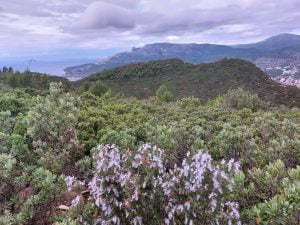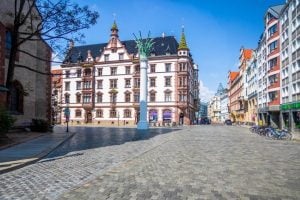Explore the Azores, a stunning archipelago in the Atlantic Ocean, with our comprehensive travel guide. Discover the natural beauty, unique culture and hidden gems of these Portuguese islands.
Introduction: Discover the Azores
The Azores, an archipelago located in the middle of the Atlantic Ocean, is a magical destination that has yet to be discovered by many. This hidden gem consists of nine volcanic islands known for their stunning views, clear waters and vast biodiversity. If you are looking for a unique and unforgettable experience, the Azores are the perfect location for you.
The Azores is a place where you can connect with nature, hike its lush forests and explore its hidden lakes, waterfalls and hot springs. The islands are a haven for nature lovers who love to explore, discover and experience the beauty of nature. Whether you're looking for adventure, relaxation or a romantic getaway, the Azores has something for everyone.
It is no surprise that the Azores attract more and more visitors over the years. With its natural beauty, rich cultural heritage and delicious cuisine, the Azores are a destination that will leave you spellbound. The islands are known for their peace, tranquility and laid-back lifestyle, perfect for anyone looking to escape the hustle and bustle of city life.
The Azores are still a relatively unknown destination, which makes it even more appealing. The islands have managed to maintain their authenticity and charm, making it an ideal location for those who want to experience something different. The Azores are a perfect destination for those who like to explore, discover and experience new things.
Where are the Azores?
The Azores are a group of nine Portuguese islands located in the middle of the Atlantic Ocean. They are located about 1,500 km west of Lisbon, Portugal, and about 3,900 km east of New York, USA.
The archipelago is divided into three groups: The eastern group (Sao Miguel and Santa Maria), the central group (Terceira, Graciosa, Sao Jorge, Pico and Payal), and the western group (Flores and Corvo).
The islands are located on the Mid-Atlantic Ridge, which is an underwater mountain range that separates the North American and Eurasian tectonic plates. As a result of this location, the Azores are known for their volcanic landscapes and thermal hot springs. The islands are also home to a unique ecosystem with a huge variety of flora and fauna.
Despite their remote location, the Azores are accessible and easy to reach. There are direct flights from several major cities in Europe and North America, including Lisbon, Porto, Boston, Toronto and Frankfurt. The islands are also a popular stopover destination for transatlantic flights, making it easy to add a visit to the Azores to your itinerary.
Visitors to the Azores can expect a mild climate with temperatures ranging from 14°C to 24°C throughout the year. The islands are known for their changeable weather, with rain, wind and sun all possible in one day. However, the climate is generally pleasant, making it an excellent destination for outdoor activities such as hiking, whale watching and surfing.
When is the best time to visit?
The best time to visit the Azores depends on what you want to do and see. The islands have a mild climate throughout the year, but the weather can be unpredictable and changeable. The summer months (June to September) are the busiest and most expensive time to visit, but offer the best chance of warm, sunny weather. This is also the best time for outdoor activities such as hiking, whale watching and surfing.
If you are interested in seeing the Azores' famous wildflowers, then the spring months (March to May) are the best time to visit. During this time, the islands are covered in a carpet of colorful blooms, creating a stunning sight. This is also a good time for bird watching, as many migratory species pass through the Azores during the spring.
The autumn months (September to November) are a quieter time to visit, with fewer tourists and lower prices. The weather is still mild, but there may be more rain and wind. This is a good time for hiking and exploring the natural beauty of the islands, as the landscapes are lush and green.
Winter (December to February) is the off-season in the Azores, with fewer tourists and lower prices. The weather can be cool and wet, but it's a good time to experience the islands' thermal hot springs and natural pools. This is also a good time for whale watching, as the Azores are home to several species of whales that can be seen year-round.
How to get there?
Getting to the islands is relatively easy, with several airlines offering direct flights from major European cities. There are also regular flights from North America, including Boston, Toronto and Montreal. The Azores are served by two airports: Punta Delgada Airport on Sao Miguel Island and Horta Airport on Faial Island.
If you are coming from Europe, you can fly directly to the islands with airlines such as Ryanair, TAP Air Portugal and SATA. There are daily flights from Lisbon and Porto, as well as several flights a week from London, Amsterdam and Frankfurt.
If you're coming from North America, you can fly directly to the island region with Azores Airlines (formerly SATA) from Boston, Toronto and Montreal. These flights operate all year round and last about four hours.
Alternatively, you can fly to Lisbon or Porto and then take a connecting flight to the islands. TAP Air Portugal offers several daily flights to Ponte Delgada from Lisbon, while SATA offers several flights a week from Porto.
Once you are in the Azores, the best way to get around is by renting a car or hiring a private tour guide. Public transportation is limited, and some islands are not well connected by public transportation. Taxis are available, but can be expensive.
Island trip: a tour of all nine islands
The Azores consist of nine volcanic islands, each of which has its own unique landscape, culture and attractions. An island trip is a popular way to explore the archipelago and experience the diversity of the Azores.
If you have limited time, it is better to focus on the central group of islands, which includes Terceira, Sao Jorge, Pico, Payal and Graciosa. These islands are relatively close to each other and can be easily reached by ferry or small plane.
Teresira is known for its UNESCO-listed historic town of Angra do Heroismo, while São Jorge is famous for its stunning cliffs and hiking trails. Pico is home to Portugal's highest mountain, Mount Pico, and a thriving wine industry. Payal is known for its charming port town. Horta and its role as a stopover for transatlantic sailors Graciosa is a small island with beautiful beaches and a relaxed pace of life.
If you have more time, you can also visit the eastern group of islands, which includes Sao Miguel, Santa Maria and the small island of Corvo. Sao Miguel is the largest and most populated island, with plenty of natural attractions, including hot springs, lakes and waterfalls. Santa Maria is a lesser known island with amazing beaches and a relaxed atmosphere. Corvo is the smallest and most remote of the islands, with a rugged landscape and a population of only a few hundred people.
What natural wonders can we expect?
The Azores are a paradise for nature lovers, with plenty of natural wonders to discover. From volcanic mountains to clear lakes, the archipelago is a feast for the senses.
One of the most iconic natural wonders of the Azores is the Sete Cidades Crater, a stunning twin lake located on the island of São Miguel. The lakes are surrounded by lush green hills and offer breathtaking views from different vantage points.
Another must-see attraction is the Caldeira das Sete Cidades, a huge caldera located on the same island. The crater is home to a variety of flora and fauna, including endemic species found nowhere else in the world.
The Azores are also known for their impressive waterfalls, with many of them located on São Miguel Island. The Salto do Prego waterfall is a popular spot for swimming and picnicking, while the Ribeira dos Caldeiroes waterfall is surrounded by beautiful gardens and walking trails.
For those who love hiking, the regional areas have a variety of trails to explore, from easy hikes to challenging hikes. The Faial da Terra Trail in São Miguel is a relatively easy hike that takes you through dense forests and past waterfalls, while the challenging hike in the Pico Mountains rewards you with panoramic views of the archipelago.
The Azores are also home to a variety of marine life, including whales, dolphins and sea turtles. Whale watching tours are a popular activity, with the opportunity to see species such as sperm whales and blue whales.
The Azores: a haven for nature lovers
The Azores are a destination for nature lovers of all kinds. With the diverse scenery of mountains, lakes and coastlines, there is no shortage of activities to enjoy. Whether you are an avid hiker, surfer or diver, the Azores has something to suit your interests.
Hiking is one of the most popular activities in the Azores, with a variety of trails to explore. São Miguel Island alone has over 30 different hiking trails, ranging from easy walks to challenging hikes. The trails take you through stunning landscapes, including forests, waterfalls and volcanic craters.
For those who love water sports, the Azores are paradise. The archipelago is known for its world-class surfing, with waves that can reach heights of up to 30 meters. Santa Maria Island is a popular spot for surfing, with a variety of breaks to choose from. Diving is also a popular activity in the Azores, with the opportunity to explore the underwater world and see a variety of marine animals up close.
The Azores are also an excellent destination for adventure sports, including canyoning, kayaking and rock climbing. Flores Island is especially popular for canyoning, with its rugged landscape and impressive waterfalls. Kayaking is a great way to explore the coastline and see the islands from a different perspective.
If you prefer a more relaxed pace, the Azores also offer a variety of leisurely activities. The archipelago is home to several golf courses, including the Batalha Golf Course in Sao Miguel. The islands also have a variety of parks and gardens to explore, including the Terra Nostra Garden in Sao Miguel.
Kitchen: What's on the regional menu?
The Azores are a destination that offers not only breathtaking natural beauty but also a unique culinary experience. Azores cuisine is heavily influenced by the sea, with plenty of fresh seafood on offer. The islands are also known for their dairy products, such as cheese and butter, as well as their beef and pork dishes.
One of the most popular dishes in the regional area is cozido das Furnas, a dish cooked underground using the natural heat of volcanic steam. The stew is made from a variety of meats, vegetables and legumes and is a hearty and satisfying meal. Another popular dish is lapps, which are limpets cooked in a garlic and butter sauce and served with bread.
Seafood lovers will be in heaven in the Azores, with a variety of fish and shellfish. One of the most popular seafood dishes is caldirada, a fish stew made from a variety of fish and vegetables. Another popular dish is octopus, often served grilled or boiled.
The Azores are also known for their cheese, with a variety of different types on offer. One of the most popular is queijo da ilha, a semi-hard cheese made from cow's milk. The cheese is aged for at least three months and has a unique slightly sharp and nutty taste.
When it comes to desserts, the Azores have a variety of delicious options. One of the most popular is Massa sovada, a sweet bread that resembles a Portuguese brioche. The bread is often served with butter and jam or used to make French toast. Another popular dessert is queijadas, which are small cakes made with cheese, sugar and eggs.
Festivals and cultural events
The Azores are a destination rich in culture and history, and this is reflected in the many festivals and cultural events held throughout the year. One of the most popular events is the Festa do Santo Cristo dos Milagres, held in Punta Delgada on the island of São Miguel. This festival is one of the biggest religious events in Portugal and attracts thousands of visitors every year. The festival celebrates the miracle of the Holy Messiah of Miracles, and includes a procession through the streets of Punta Delgada, as well as music and dancing.
Another popular event is the Semana do Mar, which takes place in Horta on the island of Faial. This festival celebrates the sea and includes a variety of activities such as yacht races, swimming competitions and traditional regional music. The festival is a great opportunity to experience the regional culture and meet the locals.
The Azores are also known for bullfighting, which is a traditional sport that has been practiced on the islands for over 200 years. Unlike Spanish bullfights, regional bullfights are non-lethal and involve a team of bullfighters working together to dominate the bull. The bullfighting season runs from May to October, and there are several bullfighting events held on each of the islands.
Other cultural events in the Azores include the Holy Spirit Festival, which takes place on all the islands and includes parades, food and traditional music. There is also the Azores Festival, which takes place in Lisbon and is a celebration of Azores culture and heritage.
Sustainable tourism: respecting the environment
The Azores is a destination that places a strong emphasis on sustainable tourism, meaning the promotion of responsible travel practices that minimize negative impacts on the environment, culture and local communities. The islands are home to several natural wonders, from volcanic landscapes to marine life, and it is important to protect these treasures for future generations.
One of the ways the Azores promotes sustainable tourism is through eco-friendly accommodations, designed to minimize energy consumption and waste. Many hotels and guesthouses on the islands use renewable energy sources such as solar and wind power, and offer recycling programs to guests.
Another way the Azores promote sustainable tourism is through outdoor activities that are environmentally friendly and educational. For example, visitors can go on guided tours with local experts who can offer insights into the islands' unique flora and fauna. There are also opportunities to watch whales and dolphins, which can be done in a responsible and respectful way that does not harm the animals.
The Azores are also a destination that promotes sustainable food practices, focusing on the use of local and organic ingredients. Visitors can dine at restaurants that support local farmers and fishermen, and enjoy traditional regional dishes made with fresh seasonal ingredients.
The history of the Azores
The Azores have a rich and complex history spanning thousands of years, with evidence of human settlement dating back to the Neolithic period. The islands were first officially discovered by Portuguese explorers in the 15th century, and soon became an important stopping point for ships traveling between Europe, Africa and America.
Over the centuries, the Azores have been home to a number of different cultures, including the original indigenous populations, the Portuguese, and various immigrant groups from around the world. This diverse heritage is reflected in the architecture, cuisine and customs of the islands, which combine to create a unique and fascinating cultural landscape.
One of the most significant events in the history of the Azores was the construction of a number of forts and military installations during the 16th and 17th centuries, designed to protect the islands from attacks by foreign powers. Many of these fortifications still stand today, and visitors can explore their impressive walls and learn about their strategic importance in the history of the Azores.
Another important aspect of regional history is the role of the islands in the development of the whaling industry. For centuries, regional whalers braved the treacherous waters of the Atlantic Ocean to hunt these enormous marine mammals, and the industry played a central role in the islands' economy and culture. Today, visitors can learn about the history of whaling in the Azores in museums and cultural centers around the islands.
Watching whales and dolphins: a popular attraction
The Azores are one of the best places in the world to watch whales and dolphins, with over 25 different species of cetaceans found in the waters surrounding the islands. The islands' location in the middle of the Atlantic makes it an ideal location for these magnificent creatures to breed and feed, and visitors to the Azores have a high chance of spotting them on a whale watching tour.
There are several different companies that offer whale watching tours in the Azores, with boats departing from various ports on the islands. These tours usually last between two and four hours, and are led by experienced guides who are knowledgeable about the local marine life.
One of the most popular species of whales to spot in the Azores is the sperm whale, which can reach up to 20 meters in length and is a regular visitor to the islands. Other species that can be seen include the humpback whale, the fin whale and the blue whale, which is the largest animal on Earth.
In addition to whales, the waters around the Azores are also home to several different species of dolphins, including the common dolphin, the bottlenose dolphin and the spotted dolphin. These playful and intelligent animals are often seen jumping and frolicking in the waves alongside boats on whale watching tours.
Visitors to the Azores should be aware that whale watching tours are responsible and sustainable, with strict regulations to protect the marine environment and the animals themselves. Guides are trained to approach the whales and dolphins in a respectful and non-intrusive manner, and visitors are asked to follow certain guidelines to ensure their presence does not disturb the animals.
The Azores are UNESCO World Heritage Sites
The island region has a rich cultural and historical heritage, and several sites on the islands have been recognized by UNESCO as a World Heritage Site. One of them is the historical center of Angra do Heroísmo on the island of Terceira, which was recognized by UNESCO in 1983. The town was an important center of trade and commerce during 16th and 17th centuries, and its historic streets and buildings reflect this. A vibrant history. Visitors can explore the town's many churches, palaces and fortifications, as well as the beautiful harbor and surrounding countryside.
Another UNESCO World Heritage Site in the Azores is the vineyards of Pico Island, which were recognized in 2004. These vineyards are unique in the world, as they grow in the rocky terrain of the island's volcanic landscape and are protected by stone walls built by hand over several centuries. The wine produced from these vineyards Famous throughout Portugal and beyond, visitors can taste it in local wineries and restaurants.
The third UNESCO World Heritage Site in the Azores is the Landscape of the Vineyard Culture of Pico Island, recognized in 2014. This site encompasses the vineyards themselves, as well as the surrounding landscape and traditional farming methods passed down through generations. Visitors can walk among the vineyards and explore the the rugged coast of the island, and observe the amazing natural beauty of this unique landscape.
Hot springs and thermal pools
The Azores are home to a number of hot springs and thermal pools, popular with visitors seeking relaxation and rejuvenation. One of the most famous of these is the Terra Nostra Garden on Sao Miguel Island, which boasts a large thermal pool filled with mineral-rich water. The garden itself is also a beautiful place to explore, with exotic plants and trees from all over the world.
Another popular hot spring in the Azores is Poça da Dona Beija on São Miguel Island, which features several natural pools with warm volcanic water. Visitors can relax in the pools surrounded by lush vegetation and towering palm trees, creating a serene and peaceful atmosphere.
On Terceira Island, visitors can take a dip in the natural hot spring at Furnas do Enxofre, located in the middle of a volcanic crater. The sulfur-rich waters are said to have therapeutic properties and can be a great way to relax after a day of exploring the island.
Other hot springs and thermal pools in the Azores include Caldeira Velha in Sao Miguel, Tramas de Praia in Sao Miguel and Possa de Dona Ana in Faial Island. Each of these places offers a unique and immersive experience, allowing visitors to connect with the natural beauty of the islands and enjoy a relaxing and rejuvenating dip in the warm waters.
Regional handicraft art
The Azores are known for their traditional handicrafts, which are created using techniques passed down through generations. Visitors to the islands can explore the many workshops and markets where these beautiful handicrafts are sold, offering a unique insight into local culture and traditions.
- tissue:
One of the most famous regional handicrafts is embroidery, which is known for its intricate designs and delicate beauty. Embroidery is a traditional craft that has been practiced in the Azores for centuries, with each island having its own unique style and techniques. Visitors can find embroidered items such as tablecloths, napkins and clothes, which are beautiful and meaningful souvenirs. - clay:
Another popular handicraft in the Azores is pottery, which is created using local clay and traditional firing techniques. The island of Sao Miguel is particularly known for its pottery, which features intricate designs and patterns inspired by the islands' natural beauty. Visitors can find a variety of pottery items such as plates, bowls and vases, which are both functional and beautiful. - Lace production:
Lace making is another traditional Azores craft, with each island having its own unique style and techniques. The lace is created using fine threads and intricate patterns, with some pieces taking months to complete. Visitors can find lace items such as napkins, tablecloths and clothes, which are beautiful and delicate souvenirs. - Local markets:
Visitors to the Azores can explore the many local markets where they can find a variety of traditional handicrafts and souvenirs. The markets offer a great opportunity to connect with local artisans and learn more about the techniques and traditions behind each craft. Visitors can also find a variety of locally produced food and drink, such as cheese, wine and tea, which are delicious and unique souvenirs.
Nightlife and entertainment
The Azores may not be the first place that comes to mind when you think of nightlife and entertainment, but that doesn't mean there isn't much to do after sunset. Each island has its own unique nightlife scene, from cozy bars to lively clubs and everything in between. Whether you're looking for a quiet drink with friends or a night of dancing, there's something for everyone.
One of the popular nightlife spots in the Azores is Punta Delgada, the capital city of São Miguel. Here you will find a variety of bars and clubs, many of which stay open until the early hours of the morning. The city also hosts regular events and festivals, such as the regions annual Fringe Festival, which celebrates local art and culture.
If you are looking for a more relaxed evening, head to one of the many cozy bars and cafes scattered around the islands. These offer a great opportunity to relax with a drink and soak up the local atmosphere. Many of these bars also offer live music, with local musicians performing traditional regional music.
For a truly unique experience, head to Furnas in Sao Miguel, where you can enjoy a traditional regional meal cooked in the natural hot springs. This is a popular evening activity, with many restaurants offering this unique dining experience.
If you're visiting the Azores during the summer months, be sure to check out the many festivals and outdoor events that take place. From music festivals to street parties, there's always something going on during the warmer months.
Safety tips for a worry-free trip
The Azores are generally a very safe destination for travelers, with a low crime rate and friendly locals. However, as with any destination, it's important to take precautions to ensure a worry-free trip. Here are some safety tips to keep in mind:
- - Pay attention to your belongings:
While the crime rate is low, petty theft can still occur. Keep your valuables close to you and be aware of your surroundings, especially in busy tourist areas. - - Follow the weather alerts:
The Azores are known for their unpredictable weather, and storms can strike suddenly. Check weather forecasts and follow any alerts or warnings issued by local authorities. - - Be careful when traveling:
The Azores are a paradise for nature lovers, with many hiking trails and natural wonders to explore. However, it is important to take precautions when hiking, such as bringing plenty of water, wearing appropriate footwear, and staying on marked trails. - - Respect the environment:
The Azores are known for their natural beauty, and it is important to respect the environment. Avoid littering and follow any signs or rules in place to protect the local flora and fauna. - - Be aware of volcanic activity:
The Azores are home to several active volcanoes, and it is important to be aware of any potential risks. Follow all advice issued by local authorities and avoid restricted areas. - - Follow local customs:
The Azores have a rich culture and many unique customs. Be respectful of the locals and follow any customs or traditions that may be different from what you are used to.
Useful phrases to know
If you are planning a trip to the islands, it can be helpful to know some basic Portuguese phrases. While many locals speak English, knowing a few phrases can go a long way in making connections and showing respect for the local culture. Here are some useful phrases to know:
- Greetings and polite expressions:
- - "Boom Dia" - Good morning
- - "Boa Tarde" - Good afternoon
- - "Boa Nuta" - Good evening
- - "Por Tova" - please
- – "Obrigado/a" – Thank you (male/female)
- – "Da Nada" – you are welcome
- – "Com licença" – sorry
- Basic phrases:
- – "Sim" – yes
- - "Nau" - no
– "Fala inglês?" - Do you speak english?
– "Eu não falo português" – I don't speak Portuguese
– "Quanto Costa?" - How much does it cost? - – "Onda Pika…?" - Where...?
– "Posso ter o menu, por favor?" – Can I have a menu please? - Food and drinks:
- – "Água" – water
- – "Cerveja" – beer
- – "Vino" – wine
- - "Coffee Coffee
- – "Cha" – tea
- – "Pikes" - a fish
- - "Carna" - meat
- - "legumes" - vegetables
Conclusion: a trip of a lifetime
The Azores are a truly unique destination that offers a wide variety of experiences for travelers. From exploring natural wonders to enjoying the local cuisine and culture, there is something for everyone. Whether you're an outdoor enthusiast or a history buff, the Azores will not disappoint.
A visit to the Azores is an opportunity to disconnect from the everyday hustle and bustle and delve into the beauty of nature. With nine islands to explore, each with its own unique landscapes and attractions, an island trip is a must-do for any traveler.
The Azores also offer an opportunity to experience sustainable tourism, focusing on refreshment and preserving the environment. This creates a more authentic and responsible travel experience.
The Azores guide for travelers:
| an island | Main attractions | Cost per day | Recommended duration |
|---|---|---|---|
| Sao Miguel | Volcanic lakes, hot springs | 50 | 3-4 days |
| Terceira | Museums, historical sites | 45 | 2-3 days |
| pico | Whale watching, vineyards | 60 | 2-3 days |
| Payal | Lighthouse, Caldera | 55 | 2-3 days |
With its fascinating landscapes, rich history and charming local culture, the Azores are a must-see for any avid traveler. Plan your dream trip to this magical archipelago today and experience the wonders of these islands for yourself.



















